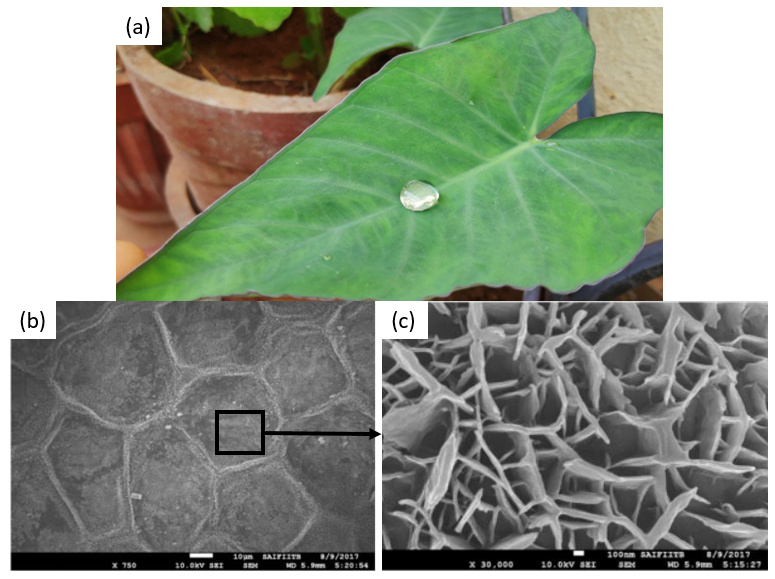It was a rainy afternoon, while I was drying freshly washed Taro (Colocasiaesculenta) leaves, which is a key ingredient in the preparation of an authentic Mangalorean snack called ‘Pathrode’ (pronounced as ‘pa-throw-day’ in Kannada and Konkani, audio link: https://drive.google.com/file/d/1cHm_0DaGxVhWgQZv15CEed-x8x2L39Vt/view?usp=sharing). Pathrode is a steamed roll of taro leaves coated with coconut and rice,blended with a heavenly concoction of spices, enhanced with the mouth-watering tanginess of tamarind and a subtle hint of sweetness fromjaggery. As I picked up the wet taro leaves, pearl-like droplets of water would effortlessly roll down the leaves with absolutely no wetting (Video link: https://drive.google.com/file/d/1NeNob-GRFXB8Jl1ySK7JzopTvtrBWqTI/view?usp=sharing). To further experiment, I rubbed off a small area of the leaf’s surface against the table and tried sprinkling a few drops of water on the leaf, and to my surprise, no pearl-like dropletswere formed. As I continued this experiment, I could not help but notice the stares I got from my mother, vexed for wasting her time. I quickly wound up the work and began to read up about this astonishing phenomenon.
Essentially, the taro leaves have a two-tiered structure with primary hexagonal microcavities resembling a honeycomb structure and a secondary flaky nanostructure that bestows the leaves with remarkable water repellency properties (https://doi.org/10.1038/s41598-020-57410-2).Thestatic contact angle, advancing angle, receding angle and contact angle hysteresis are around 150⁰, 153⁰, 144⁰ and 9⁰respectively,implying that the leaf shows excellent superhydrophobic(extremely difficult to wet) characteristics.In my little experiment,the abrasion during rubbing may have disfigured these intricate microstructures,thereby resulting in lowered water repellency.
Furthermore, a group of researchers has attempted to create a bioinspired surface, mimicking the microstructure of the taro leaf surface using photolithography techniques on a silicon wafer(https://doi.org/10.1038/s41598-020-57410-2). The bioinspired surface showed properties on-par with the taro leaves, thereby rendering it worthy for application in devices that require water repellency. This bioinspired surface qualifies as what is called a biomimetic material.
| Image: (a) Drop of water on a taro leaf; Scanning electron microscope image of the surface of the taro leaf revealing: (b) the primary honeycomb structure (magnification: 750X), (c) the secondary flaky nanostructure(magnification: 30000X).Image courtesy:https://doi.org/10.1038/s41598-020-57410-2 | |
 |
Biomimetics is the field of science that derives lessons from biological systems to design materials or models that can imitate the functional properties of that system. Living organisms fabricate materials using complex mechanisms that achieve bizarrely high orders of accuracy. ‘Survival of the fittest’, a harsh yet successful principle of nature, has driven living organisms to evolve numerous such mechanisms to assemble chemical materials through complex pathways to achieve accurately defined architectures with multifunctional properties. These properties collectively assist food procurement, protection and umpteen other physiological processes. While living cells are the functional laboratories, the constituent macromolecules behave as workbenches to synthesize these magnificent micro and nanostructures.
To cite another interesting example, the microscopic bristles of a Gecko’s feet that keep it anchored to the smoothest of surfaces by mere van der Waals forces has inspired the innovation of next-generation adhesive tapes (Ref:https://doi.org/10.1007/s12541-010-0020-5). There are a million more such systems in the biological world that are patiently waiting to inspire scientists to fabricate biomimetic materials with superior properties. A watchful eye, an open mind and skillful hands are all that it takes for a researcher to implement the profound and thrilling intricacies of nature in his/her laboratory. I couldn’t agree more with Albert Einstein when he once said, “Look deep into nature, and then you will understand everything better”.
-Nikhil N. Rao
Ph.D. scholar
Group of Dr. Neena S. John
CeNS, Bengaluru

Nicely written very informative. Thank you
Enjoyed reading it Nikhil.Beautiful description and loved the way u have connected a scientific phenomenon to natures beauty. Waiting for many more of such. All the best
The article is profoundly written. Our universe presumes objects that need comprehensible study!! A simple and yet powerful experiment.
It was a wonderful read Nikhil. It’s quite fascinating that nature has such trailblazing ideas; science is yet to disclose many of them.
This blog was very informative. The structure and tone of the article was easy to follow and understand.
This topic is unique and amusing, I had fun reading about biomimetics.
Nice and informative blogpost! Thanks, Nikhil.
Wonderfulful article about the nature and it’s secrets which are still to be utilised. All the best Nikhil.
Well written, keep up the good work.
A good read, Nikhil. I was just wondering what happens to the hydrophobic feature when the leaf dries up. Would that be similar to the rubbed leaf situation that you mention? Also, is there a relation between the extent of hydrophobicity and the periodicity of the underlying nanostructure?
Very well explained about the bio-mimetic structures with an intresting description. Enjoyed reading.
Nice information, written in a simple way. Congratulations Nikhil !